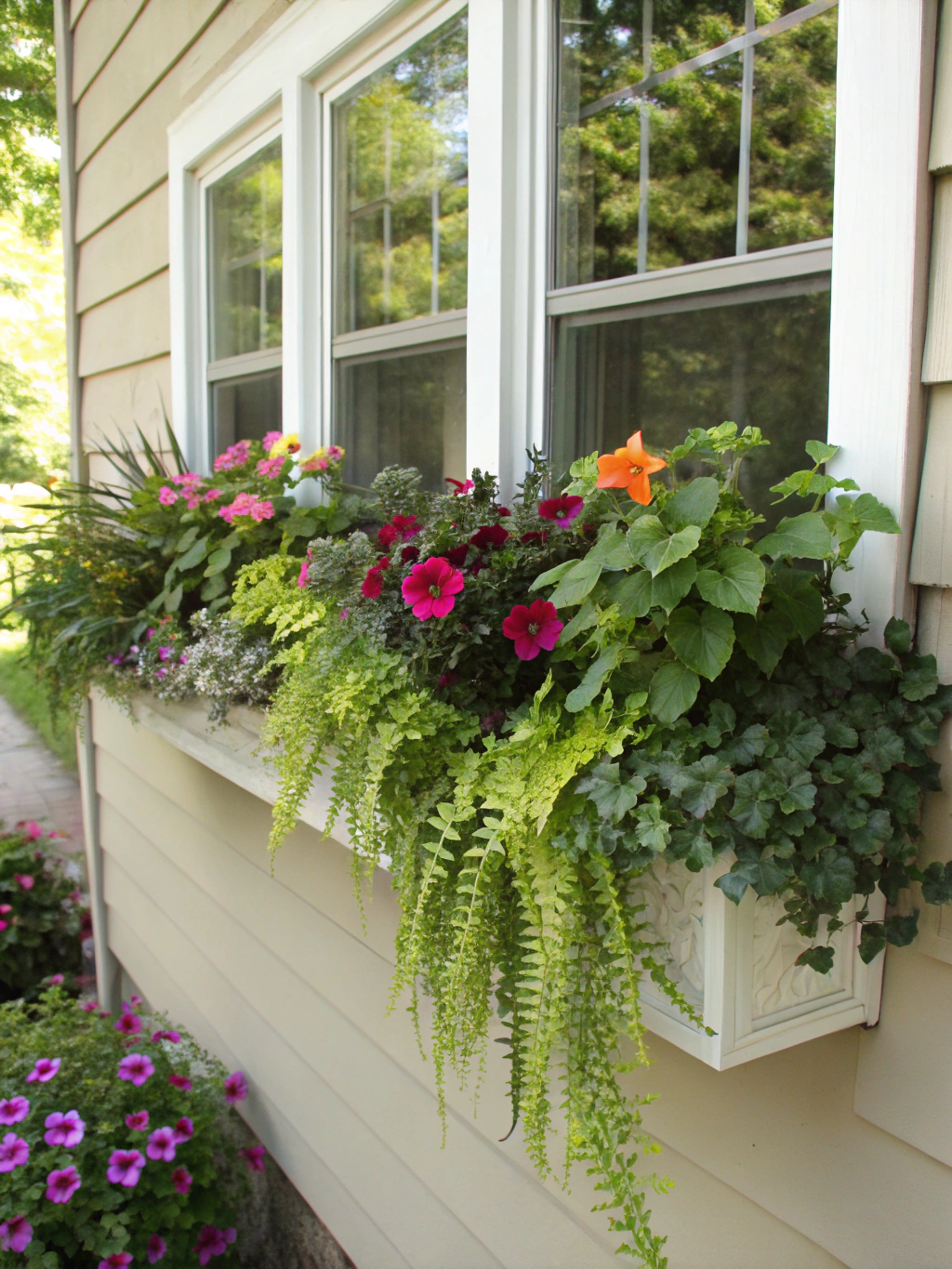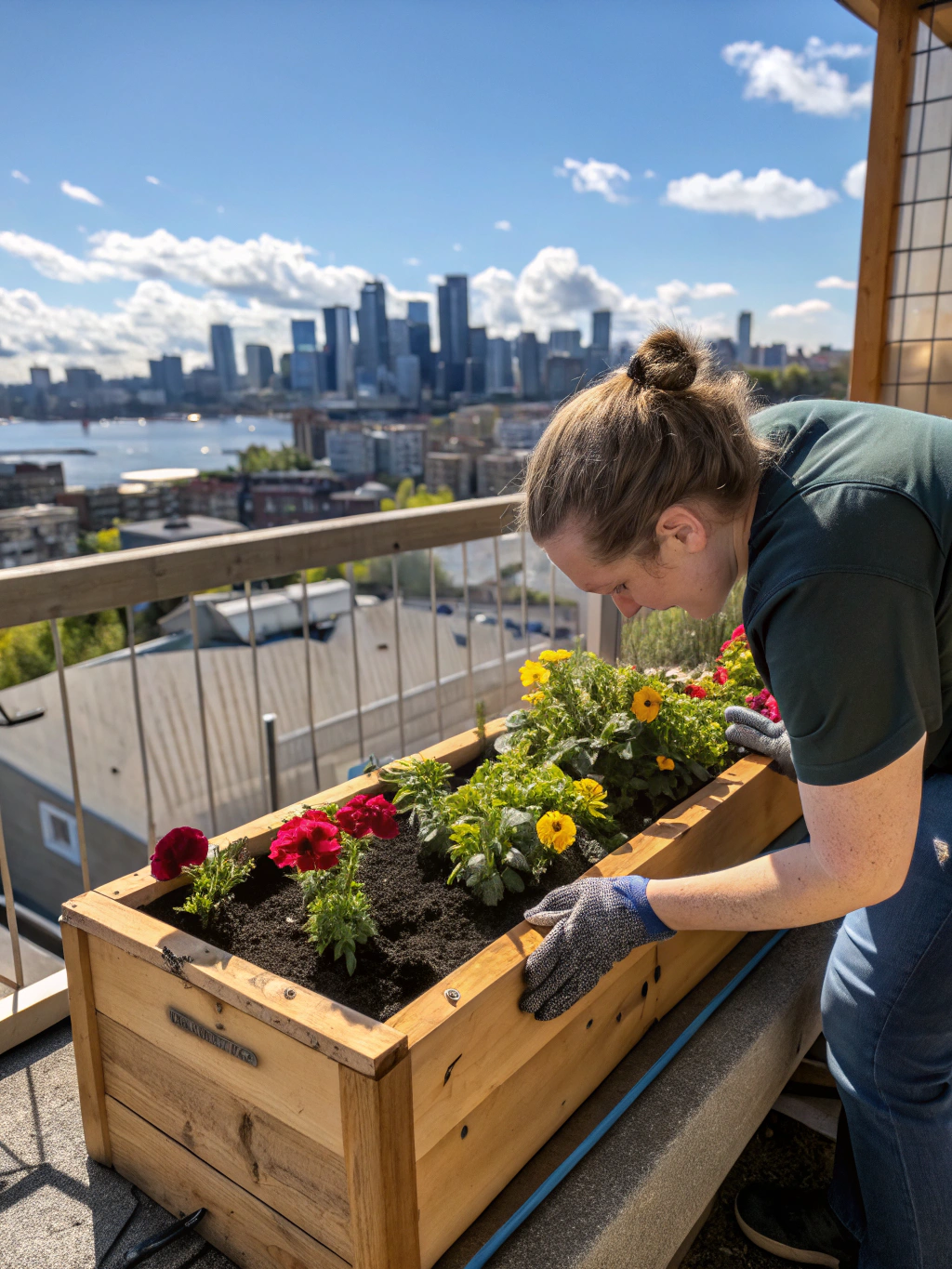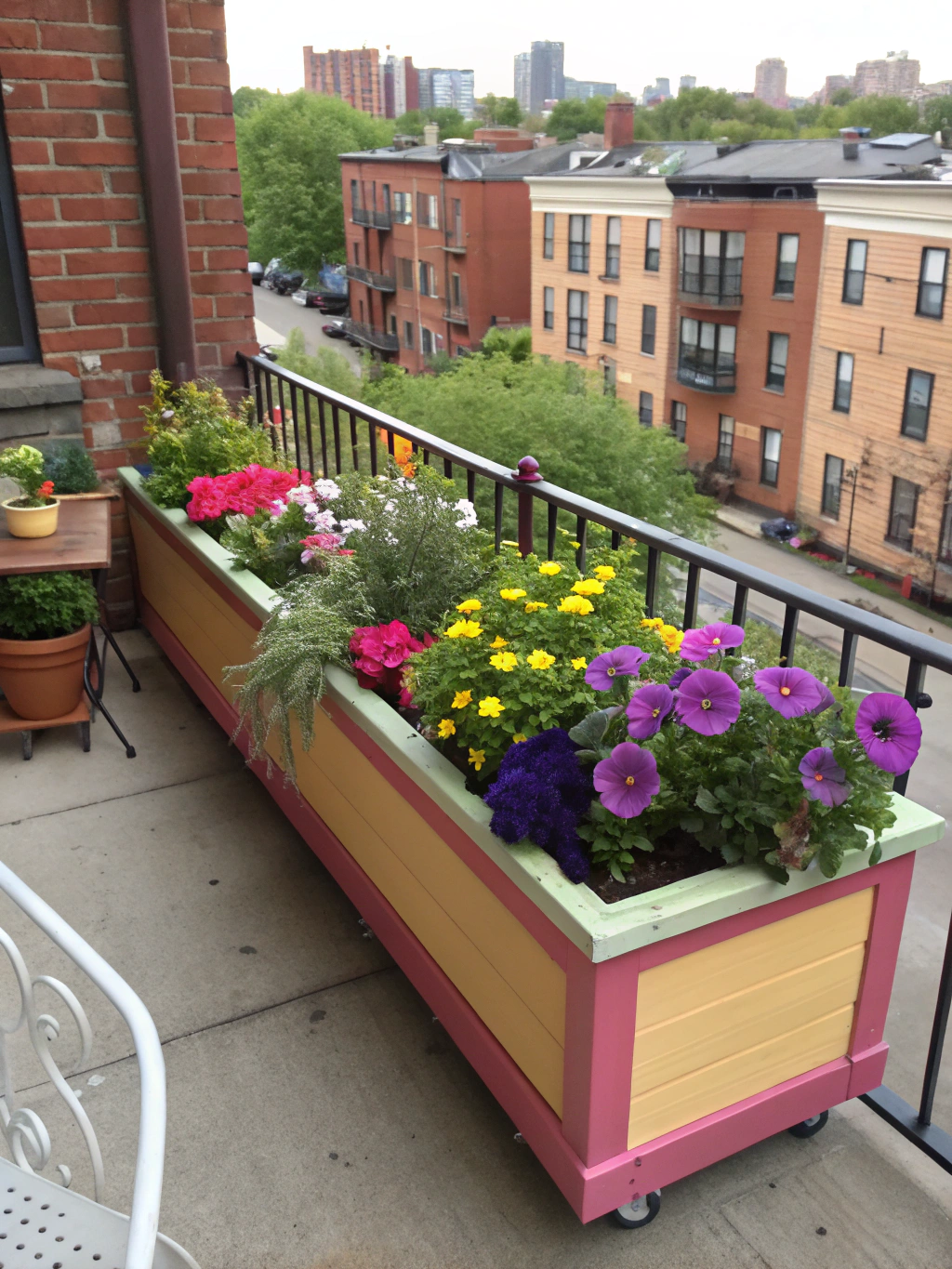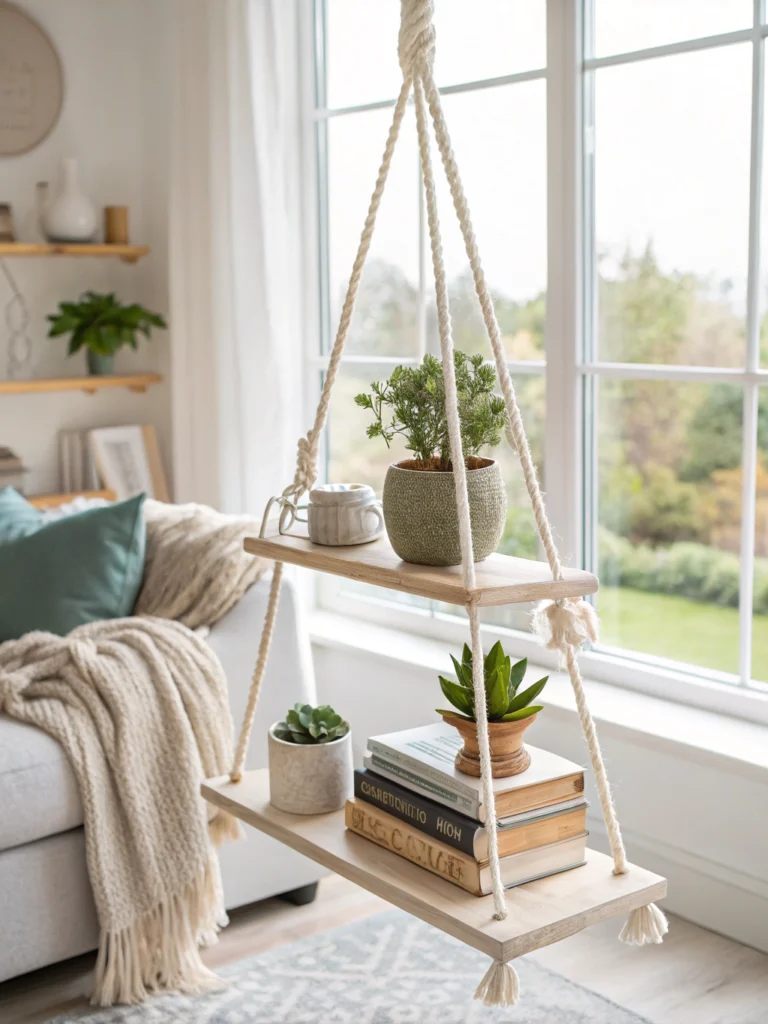
Caption: Transform your balcony into a vibrant oasis with your very own DIY window box planter.
Introduction
Hey there, fellow home improvement enthusiasts! Are you dreaming of a balcony bursting with colorful blooms or a windowsill overflowing with fresh herbs, but feel a bit intimidated by where to start? Many of us look at those gorgeous magazine-worthy outdoor spaces and think they’re out of reach, or that custom planters are too expensive. Well, I’m here to tell you that creating a stunning display is easier (and more rewarding!) than you think with a DIY window box planter. This guide will walk you through everything, making the process of building a DIY window box planter fun and straightforward.
Imagine stepping out onto your balcony each morning to be greeted by a खुशबूदार, vibrant collection of your favorite plants, all housed in a beautiful planter you built with your own two hands. It’s not just about adding greenery; it’s about creating a personal sanctuary, a little piece of nature that reflects your style and effort.
Building a DIY window box planter is a fantastic weekend project that adds instant curb appeal and a whole lot of charm to any outdoor area, big or small. We’re going to cover everything from planning and material selection to the final flourish of planting your chosen botanicals. So, grab a cup of coffee, and let’s get ready to transform that bland balcony or windowsill into a blooming paradise! We’ll explore some fantastic “DIY window box planter ideas, Building a DIY window box planter, How to create a DIY window box planter” to get your creative juices flowing.
Table of Contents
What You’ll Need for Your DIY window box planter
Before we dive into the sawdust and soil, let’s gather all our supplies. Having everything ready beforehand makes the process of building a DIY window box planter much smoother and more enjoyable. Think of it as your mise en place for DIY success!

Caption: Gather these essentials before you begin crafting your DIY window box planter.
Here’s a comprehensive list of materials and tools you’ll likely need. Remember, dimensions and specific wood types might vary based on your design and where your DIY window box planter will live.
Materials:
- Lumber: The star of the show!
- Cedar or Redwood: Naturally resistant to rot and insects, making them excellent choices for outdoor projects like a DIY window box planter. They can be pricier but offer longevity.
- Pine: A more budget-friendly option. It will need to be properly sealed and painted/stained to protect it from the elements, especially if it’s for an outdoor DIY window box planter.
- Pressure-Treated Lumber: Resistant to rot and insects, but ensure it’s safe for plants (look for newer, less toxic treatments if planting edibles). It’s also crucial to let it dry completely before working with it.
- Quantity: This will depend on the size of your DIY window box planter. We’ll cover measuring in the first step. Typically, you’ll need 1×6 or 1×8 boards for the sides and bottom.
- Wood Screws:
- Exterior-grade screws are a must to prevent rust and ensure durability. Choose a length appropriate for the thickness of your lumber (e.g., 1 ¼-inch or 1 ½-inch screws for ¾-inch thick boards). Stainless steel screws are a top-tier choice.
- Wood Glue:
- Waterproof or water-resistant wood glue (like Titebond II or III) will add significant strength to the joints of your DIY window box planter.
- Sandpaper:
- Various grits (e.g., 80-grit for rough shaping, 120-grit for smoothing, and 220-grit for a fine finish before painting/staining).
- Wood Filler (optional):
- For filling screw holes or small imperfections for a cleaner look. Choose an exterior-grade, paintable/stainable filler.
- Primer & Exterior Paint or Stain/Sealer:
- Crucial for protecting your DIY window box planter from moisture and UV rays. Choose a color or finish that complements your home’s exterior.
- Plastic Liner or Landscape Fabric (optional but recommended):
- This lines the inside of your DIY window box planter, creating a barrier between the moist soil and the wood, extending its lifespan. It also helps retain soil.
- Gravel or Small Stones (for drainage):
- A layer at the bottom of the DIY window box planter aids in water drainage, preventing waterlogged roots.
- Potting Mix:
- Choose a high-quality mix suitable for the types of plants you intend to grow.
- Plants!
- The fun part! Select flowers, herbs, or succulents that suit your climate and the amount of sunlight your DIY window box planter will receive.
Tools:
- Measuring Tape: Accuracy is key!
- Pencil: For marking your cuts.
- Safety Glasses: Non-negotiable! Protect your eyes from dust and debris.
- Work Gloves: To protect your hands.
- Saw:
- Hand Saw: Good for a few simple cuts.
- Circular Saw or Miter Saw: Ideal for making straight, precise cuts quickly, especially if you’re building multiple DIY window box planter units or a larger one.
- Power Drill:
- For drilling pilot holes (prevents wood splitting) and driving screws.
- Assorted drill bits, including a countersink bit if you want a neater finish for your screw heads.
- Clamps:
- At least two or three clamps (bar clamps or C-clamps) are incredibly helpful for holding pieces together while gluing and screwing.
- Carpenter’s Square or Speed Square:
- Essential for ensuring your corners are 90 degrees, leading to a sturdy and professional-looking DIY window box planter.
- Paint Brushes or Rollers:
- For applying primer, paint, or stain.
- Staple Gun (optional):
- Useful if you’re using a plastic liner or landscape fabric inside your DIY window box planter.
- Level:
- To ensure your DIY window box planter is installed straight if you’re mounting it.
Having these items on hand will streamline your project. Now that we’re prepped, let’s move on to the exciting part – building your very own DIY window box planter!
Step-by-Step Guide to Your Blooming DIY window box planter
Alright, DIY warriors, it’s time to bring your DIY window box planter to life! We’ve broken down the process into five manageable steps. Take your time, enjoy the process, and remember that even small imperfections add character to handmade items.
Step 1: Planning, Measuring, and Designing Your DIY window box planter
This foundational step is arguably the most crucial for a successful DIY window box planter project. A little forethought here will save you headaches later and ensure your planter fits perfectly and looks fantastic.
First, decide on the location. Will your DIY window box planter sit on a windowsill, hang from a balcony railing, or be mounted directly to a wall? The location dictates the maximum size and weight your planter can be, and also how you’ll secure it. Measure the available space carefully – length, width (depth from front to back), and desired height. Consider the “view” from both inside and outside. You don’t want it to be so tall it blocks your window, or so shallow your plants don’t have enough root space. For windowsill planters, ensure it won’t impede window operation. For railing planters, you’ll need to think about specific mounting brackets.
Next, sketch out a simple design. A basic rectangular box is the easiest to build and is a classic look for a DIY window box planter. Your planter will consist of five main pieces: a bottom, two long sides, and two short ends. Let’s say you want your planter to be 36 inches long, 8 inches deep (front to back), and 8 inches tall. If you’re using ¾-inch thick lumber:
- Bottom piece: 36 inches long x (8 inches – 2 * ¾ inch for side thickness) = 36″ x 6.5″
- Long side pieces (x2): 36 inches long x 8 inches tall
- Short end pieces (x2): (8 inches – 2 * ¾ inch for side thickness) wide x 8 inches tall = 6.5″ wide x 8″ tall. Correction: The short end pieces will determine the final external width. If the bottom piece is 6.5″ wide and the sides attach to the edges of the bottom piece, then the internal width is 6.5″. If the sides attach around the bottom piece, the bottom piece needs to be the full desired internal width. Let’s simplify and assume the sides will sit on top of the bottom piece, and the ends will butt against the sides and bottom.
A more common construction method for a DIY window box planter is where the side pieces overlap the edges of the bottom piece, and the end pieces overlap the edges of the sides and bottom. For an external dimension of 36″ L x 8″ W x 8″ H, using ¾” lumber:
- Bottom piece: (36″ – 2 * ¾”) L x (8″ – 2 * ¾”) W = 34.5″ L x 6.5″ W.
- Long side pieces (x2): 36″ L x 8″ H.
- Short end pieces (x2): 8″ W x 8″ H. (These will overlap the ends of the long side pieces).
It’s essential to visualize how the pieces join. Sketching helps immensely!
Finally, choose your materials based on your budget, desired look, and the planter’s exposure to weather. Cedar is fantastic for a long-lasting DIY window box planter, but treated pine is a good alternative if sealed well. This planning stage is key to “How to create a DIY window box planter” successfully.
Step 2: Cutting Your Lumber for the DIY window box planter
With your measurements and design finalized, it’s time to make some sawdust! Precision in cutting is vital for a DIY window box planter that fits together snugly and looks professional. Remember the golden rule: “Measure twice, cut once.”
Set up a safe cutting area. If you’re using a power saw, ensure you’re familiar with its operation and always wear safety glasses. Using your measuring tape and pencil, carefully mark all your cut lines on the lumber according to the dimensions you calculated in Step 1. Use a carpenter’s square or speed square to ensure your lines are perfectly perpendicular for square cuts. This is especially important for the ends of your DIY window box planter pieces.
When cutting, try to cut just on the “waste” side of your marked line. This ensures your pieces are the exact dimension you need. If you’re using a hand saw, take slow, steady strokes. If using a circular saw, guide it smoothly along your line.
A miter saw is excellent for making perfectly square (or even mitered, if you’re going for a fancier design) end cuts for your DIY window box planter. After cutting each piece, it’s a good idea to lightly sand the cut edges to remove any splinters or roughness. This makes handling them safer and prepares them for assembly. Label each piece (e.g., “bottom,” “long side,” “end piece”) with your pencil so you don’t get them mixed up. This simple trick is a lifesaver when you start assembling your DIY window box planter.
Common Pitfall: Rushing the cutting process. Inaccurate cuts can lead to gaps, an unstable structure, or a lopsided DIY window box planter. Take your time here; it pays off. Another tip is to cut all identical pieces at the same time (e.g., both long sides, then both end pieces). This helps ensure consistency.
Step 3: Assembling Your DIY window box planter
This is where your DIY window box planter starts to take shape! We’ll join the pieces together to form the main structure. Having an extra pair of hands can be helpful here, but clamps are your best friend if you’re working solo.

Caption: Step 3 in progress: Carefully assembling the frame of your DIY window box planter ensures a sturdy result.
Start with the bottom piece and the two long side pieces. Lay the bottom piece on your work surface. Apply a bead of waterproof wood glue along the top edges of the bottom piece where the long sides will attach (or along the bottom edges of the long side pieces, depending on your design – e.g., if the sides sit on the bottom piece).
Position one long side piece flush with the edge of the bottom piece. Use clamps to hold it in place. Pre-drill pilot holes through the side piece and into the edge of the bottom piece. Pilot holes prevent the wood from splitting when you drive the screws and make it easier to drive them straight. Space these holes every 6-8 inches. Then, drive your exterior-grade screws. Repeat this process for the other long side piece. Check for squareness using your carpenter’s square.
Next, attach the two short end pieces. Apply wood glue to the edges of the end pieces that will meet the long sides and the bottom piece. Fit an end piece into place, ensuring it’s flush with the ends of the long side pieces and the bottom piece. Clamp it securely. Pre-drill pilot holes through the end piece into the edges of the long side pieces and the bottom piece.
Drive your screws. Repeat for the final end piece. At this stage, your DIY window box planter structure is complete! Wipe away any excess glue that has squeezed out with a damp cloth before it dries. Let the glue cure according to the manufacturer’s instructions, typically for several hours or overnight, for maximum strength. This is a critical phase in “Building a DIY window box planter.”
Common Pitfall: Not using clamps or not pre-drilling. Clamps ensure tight joints while the glue dries and screws are driven. Skipping pilot holes, especially near the ends of boards, often leads to split wood, weakening your DIY window box planter. Also, ensure your screws aren’t too long that they poke through the other side, or too short that they don’t provide adequate holding power.
Step 4: Adding Drainage, Finishing, and Protecting Your DIY window box planter
With the main structure of your DIY window box planter assembled, it’s time for some important finishing touches that will ensure its longevity and prepare it for planting.
First and foremost: drainage. Plants hate sitting in waterlogged soil; it leads to root rot. Turn your assembled DIY window box planter upside down. Using your drill and a ½-inch to ¾-inch drill bit, drill several drainage holes in the bottom piece. Space them evenly, perhaps every 6-8 inches along the length. If your planter is wide, you might want two rows of holes. Don’t skimp on this step; good drainage is key to healthy plants.
Next, sanding. Go over all the surfaces and edges of your DIY window box planter with medium-grit sandpaper (around 120-grit) to smooth out any roughness, sharp edges, or minor imperfections. Follow up with fine-grit sandpaper (180 or 220-grit) for a really smooth finish, especially if you plan to paint it. Wipe away all sanding dust with a tack cloth or a slightly damp rag. If you have any visible screw heads you want to hide or small gaps, now is the time to apply exterior-grade wood filler. Let it dry completely, then sand it smooth.
Now for protection. This is vital for any outdoor wood project, especially a DIY window box planter that will be holding moist soil. If you’re painting, apply a good quality exterior primer first. Primer helps the paint adhere better and provides an additional moisture barrier. Once the primer is dry, apply two coats of exterior paint in your chosen color, letting it dry completely between coats. If you prefer a natural wood look, apply several coats of a good quality exterior stain and sealer, or a clear exterior wood sealant.
Pay extra attention to the inside surfaces and the bottom of the DIY window box planter, as these will be most exposed to moisture. Many “DIY window box planter ideas, Building a DIY window box planter, How to create a DIY window box planter” showcase beautiful finishes that also protect the wood.
Finally, consider lining the inside of your DIY window box planter with heavy-duty plastic sheeting (like a cut-up pond liner or thick trash bag) or landscape fabric. Cut the liner to size, press it into the box, and staple it neatly along the top inside edge, just below where the soil line will be. If using plastic, remember to poke holes in the plastic liner that align with the drainage holes you drilled in the wood bottom. This liner provides an excellent barrier against constant moisture, significantly extending the life of your wooden DIY window box planter.
Step 5: Planting and Positioning Your DIY window box planter
This is the moment you’ve been waiting for – turning your beautifully crafted DIY window box planter into a vibrant home for your plants!
Before you start adding soil, if you opted for a liner in the previous step, make sure it’s securely in place and that drainage holes are clear through both the liner and the wood. Now, add a shallow layer (about 1-2 inches) of gravel, small stones, or broken terra cotta pot pieces to the bottom of your DIY window box planter. This improves drainage by creating air pockets and preventing the soil from compacting over the drainage holes. Some gardeners skip this, especially if using a good liner and well-draining potting mix, but it can be beneficial for a wooden DIY window box planter.
Next, fill your DIY window box planter with a high-quality potting mix, leaving about 1-2 inches of space from the top rim. Don’t use garden soil, as it can be too heavy and compact easily in containers, leading to poor drainage and aeration. Moisten the potting mix slightly before or after adding it to the planter; this makes it easier to work with.
Now, arrange your plants. Think about “thrillers, fillers, and spillers” for a dynamic look. Thrillers are taller, eye-catching plants that go in the center or back. Fillers are mounded plants that surround the thriller and fill in space. Spillers are trailing plants that cascade over the edges of your DIY window box planter. Consider the mature size of your plants and give them enough space to grow. Gently remove plants from their nursery pots, loosen the root balls if they’re tightly packed, and place them in the potting mix at the same depth they were growing in their original containers. Fill in around them with more potting mix, lightly tamping it down to remove air pockets.
Once all your plants are in, water them thoroughly until water runs out of the drainage holes at the bottom of your DIY window box planter. This helps settle the soil around the roots. Finally, position your DIY window box planter in its chosen spot. If it’s being mounted, ensure your brackets are securely fastened to the wall or railing and can support the weight of the planter filled with moist soil and plants. Use a level to make sure it’s straight. Stand back and admire your handiwork!
Your Beautiful DIY window box planter: The Final Result!
And there you have it! After a bit of planning, some enjoyable crafting, and careful planting, your very own DIY window box planter is complete and ready to bring life and color to your balcony, windowsill, or patio.

Caption: The breathtaking final result – your custom-built DIY window box planter adding a splash of nature and beauty to your outdoor space!
Look at that! Isn’t it satisfying to see something so beautiful that you created with your own hands? This DIY window box planter isn’t just a container for plants; it’s a testament to your creativity and DIY spirit. It’s a focal point that will draw compliments and a source of daily joy as you watch your plants thrive. Whether it’s bursting with colorful annuals, fragrant herbs for your kitchen, or a chic arrangement of succulents, your custom planter adds a personal touch that store-bought options just can’t match.
We’d absolutely love to see what you’ve created! Share photos of your finished DIY window box planter in the comments below. What plants did you choose? Do you have any special tips or tricks you discovered along the way while building your DIY window box planter? Your insights could inspire another budding DIYer!
Pro Tips & FAQs for Your DIY window box planter
You’ve built your DIY window box planter, and it looks amazing! To help you get the most out of it and answer some common questions, here are a few pro tips and FAQs.
(Click to expand each question)
Building your own DIY window box planter is a wonderfully rewarding project that adds beauty and personality to your home. We hope this comprehensive guide has inspired you and equipped you with the knowledge to create a stunning floral display.
What are you waiting for? Get building!
We’d love to hear from you:
- Share your creations! Post a picture of your DIY window box planter in the comments below.
- Ask questions! If you’re stuck or have a query, drop it in the comments – we and the community are here to help.
- Spread the inspiration! If you found this guide helpful, please share it with your friends on social media.
Happy DIYing, and may your balconies and windowsills be ever blooming! For more DIY inspiration, don’t forget to sign up for our newsletter for regular tips, tricks, and project ideas delivered straight to your inbox.


